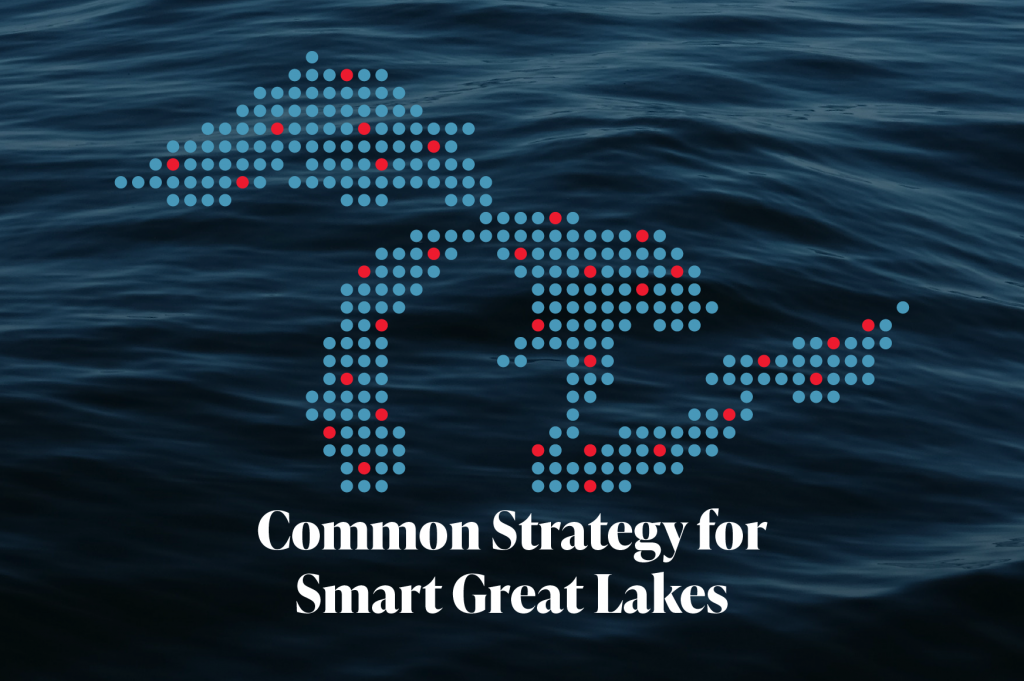FOR IMMEDIATE RELEASE: Newly Released Common Strategy for Smart Great Lakes sets goals for technology collaboration
Contact: Katie Rousseau, Smart Great Lakes Liaison, katie@glos.org, 419-215-7748
Ann Arbor, Mich.—Today, the Smart Great Lakes Initiative (SGLi) released their landmark document, “Common Strategy for Smart Great Lakes.” The document charts a course for how the initiative will advance technology applications that improve our understanding of our relationship with the Great Lakes, the largest freshwater system in the world, as both the United States and Canada prepare to recognize and celebrate the 50th anniversary of the Great Lakes Water Quality Agreement (GLWQA).
“The five Great Lakes are a globally significant natural resource, and they are under constant pressure from urban sprawl, economic activity, habitat loss and invasive species, and a rapidly changing climate,” said Mark Fisher, President and CEO of the Council of the Great Lakes Region and SGLi Leadership Team Canadian Co-chair. “For the first time ever, the Common Strategy for Smart Great Lakes aims to catapult the region ahead in using the power of data and technology to protect and sustain our relationship with this vast ecosystem, today and for future generations.”
The Common Strategy for Smart Great Lakes is inspired by past binational agreements and collaborations, such as the the GLWQA, the Boundary Waters Treaty of 1909, and the 1954 Convention on Great Lakes Fisheries, as well as other regional efforts to protect this vital resource, notably the Great Lakes Regional Collaboration which led to the creation of the successful Great Lakes Restoration Initiative in the United States.
The Common Strategy for Smart Great Lakes focuses specifically on how collaborative applications of technology can be used to address many of today’s pressing lake challenges, with an emphasis on addressing 10 key goals in three issue areas: science, innovation and technology; data and information; and policy and management.
The 10 SGLi goals are as follows:
- Develop novel and interdisciplinary research.
- Support science, innovation, and technology that improve our ability to identify, assess, and respond to stressors and change.
- Build resilient, adaptable observing systems in support of a swimmable, drinkable, fishable, and equitable future.
- Improve discoverability of Great Lakes data by increasing findability and accessibility.
- Foster data compatibility by developing a framework supporting interoperability and reusability.
- Empower data providers to share and access new data by facilitating reuse and access.
- Ensure Smart Great Lakes Common Strategy provides opportunities and resources for the First Nations, Tribes, and Métis within the Great Lakes basin through respectful engagement.
- Strengthen Great Lakes-related policies.
- Invest in Smart Great Lakes.
- Accelerate SGLi communication, outreach, education, and engagement.
The authors of the document, including university researchers, nonprofit leaders, U.S. and Canadian government officials, and others, highlight several actions for each goal. Actions span the highly technical, such as developing a data and metadata inventory, to the policy-related, like supporting science and technology educational programs for underrepresented groups.
“It was such a pleasure to be part of the Smart Great Lakes Initiative, ensuring we’re working together toward long-term, resilient watershed health! What emerged through convening experts across specialties and from both Canada and the U.S. is a framework that looks forward and gives space for the future’s environmental and societal issues,” said Kat Kavanagh, the Executive Director of Water Rangers and SGLi Innovation and Technology Canadian Co-chair.
Started in 2019, the SGLi is a collaborative consortium that is organizing the region’s technology ecosystem and network of partners around common policy goals to improve monitoring, data management and analysis, advance research, and spur technology innovation. Today, it has grown to encompass over 70 partners, including federal and university researchers, conservation organizers, business owners, technology innovators, and more in the U.S. and Canada.
“The effect of having such a diversity of sectors involved is that, by focusing on shared information, we will be able to, not only combine resources, but build a common, shared understanding of these waters—how we live and work with them and how our actions might impact them both adversely and positively,” said Michael Twiss, a professor of biology at Clarkson University and SGLi Steering Committee Co-chair.
A one-month public comment period is complete, and now SGLi partners will collaboratively focus on implementing the strategy.
In order to help imagine what “smart” means practically for projects, initiative partners published several revealing stories on current and potential projects that illustrate the spirit of the SGLi. Read them here.
Those interested in learning more can visit glos.org/priorities/smart-great-lakes/ and email Katie Rousseau at katie@glos.org.
Read the “Common Strategy for Smart Great Lakes.”
